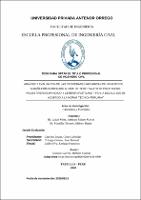| dc.contributor.advisor | Galicia Guarniz, William Conrad | |
| dc.contributor.author | Labán More, Anthony Mauro Martín | |
| dc.contributor.author | Mantilla Olivares, Mileny Sharin | |
| dc.creator | Labán More, Anthony Mauro Martín | |
| dc.date.accessioned | 2021-06-14T00:00:56Z | |
| dc.date.available | 2021-06-14T00:00:56Z | |
| dc.date.issued | 2021 | |
| dc.identifier.uri | https://hdl.handle.net/20.500.12759/7637 | |
| dc.description.abstract | Esta investigación tuvo como objetivo principal determinar los resultados de reutilizar
los residuos de plástico: Tereftalato de Polietileno y Poliestireno, como refuerzo en la
elaboración de concreto ecológico para la construcción de elementos no estructurales.
Analizar y establecer la mejora de las propiedades mecánicas de un ladrillo
agregando Tereftalato de polietileno y Poliestireno expandido en su fabricación,
definidas en la norma técnica E.070, para lo cual se fabricaron 1600 ladrillos en escala
1:25 del tamaño real, los cuales fueron confeccionados y elaborados con 15 kg de
Cemento Portland Tipo I, 2 plancha de Polietileno Expandido (Tecnopor) y 5 Botellas
de Tereftalato de polietileno (PET).
Luego de la elaboración de estas muestras, se elaboraron 40 pequeños muros con
las unidades de albañilería en la escala mencionada, en donde para el mortero se
consideró 1 kg de cemento, posteriormente se analizó su grado de absorción, el índice
de vacíos de los mismos, se realizó a su vez el ensayo de compresión diagonal de los
muros mediante una carga cíclica. Se concluyó que las propiedades mecánicas de los
ladrillos de concreto al adicionar Tereftalato de polietileno y Polietileno Expandido
reciclado no mejoran, habiendo una disminución máxima de la resistencia a
compresión del ladrillo de 59.84 kg/cm2 o 34.8%, respecto de la mezcla patrón; sin
embargo, las propiedades físico mecánicas de los tres tipos de ladrillo de concreto
con plástico PET reciclado alcanzando así cumplir con El Reglamento Nacional de
Edificaciones E-0.70 | es_PE |
| dc.description.abstract | The main objective of this research was to determine the results of reusing plastic waste:
Polyethylene Terephthalate and Polystyrene, as a reinforcement in the elaboration of
ecological concrete for the construction of non-structural elements.
Analyze and establish the improvement of the mechanical properties of a brick by
adding polyethylene terephthalate and expanded polystyrene in its manufacture,
defined in the technical standard E.070, for which 1600 bricks were manufactured in
1:25 scale of the real size, which They were made and made with 15 kg of Type I
Portland Cement, 2 Expanded Polyethylene (Tecnopor) plates and 5 Polyethylene
Terephthalate (PET) bottles.
After the elaboration of these samples, 40 small walls were elaborated with the masonry units
in the mentioned scale, where for the mortar 1 kg of cement was considered, later its
absorption degree, the void index of the same were analyzed. In turn, the diagonal
compression test of the walls was carried out by means of a cyclical load. It was concluded
that the mechanical properties of concrete bricks when adding polyethylene Terephthalate
and recycled Expanded Polyethylene do not improve, having a maximum decrease in the
compressive strength of the brick of 59.84 kg / cm2 or 34.8%, with respect to the standard
mixture; However, the physical-mechanical properties of the three types of concrete brick with
recycled PET plastic, thus complying with the National Building Regulation E-0.70 | en_US |
| dc.description.uri | Tesis | es_PE |
| dc.format | application/pdf | es_PE |
| dc.language.iso | spa | es_PE |
| dc.publisher | Universidad Privada Antenor Orrego | es_PE |
| dc.relation.ispartofseries | T_CIVIL_1947 | |
| dc.rights | info:eu-repo/semantics/closedAccess | es_PE |
| dc.rights.uri | https://creativecommons.org/licenses/by/4.0/ | es_PE |
| dc.source | Universidad Privada Antenor Orrego | es_PE |
| dc.source | Repositorio Institucional - UPAO | es_PE |
| dc.subject | Mecánicas | es_PE |
| dc.subject | Técnica | es_PE |
| dc.title | Análisis y evaluación de las propiedades mecánicas de un muro de albañilería elaborado a base de tereftalato de polietileno, poliestireno expandido y cemento portland tipo I , a escala 1/25 de acuerdo a la norma técnica peruana | es_PE |
| dc.type | info:eu-repo/semantics/bachelorThesis | es_PE |
| thesis.degree.level | Título Profesional | es_PE |
| thesis.degree.grantor | Universidad Privada Antenor Orrego. Facultad de Ingeniería | es_PE |
| thesis.degree.name | Ingeniero Civil | es_PE |
| thesis.degree.discipline | Ingeniería Civil | es_PE |
| dc.subject.ocde | https://purl.org/pe-repo/ocde/ford#2.01.00 | es_PE |
| renati.advisor.orcid | https://orcid.org/0000-0003-4506-9290 | es_PE |
| renati.author.dni | 72738250 | |
| renati.author.dni | 72622029 | |
| renati.advisor.dni | 41420875 | |
| renati.type | https://purl.org/pe-repo/renati/type#tesis | es_PE |
| renati.level | https://purl.org/pe-repo/renati/level#tituloProfesional | es_PE |
| renati.discipline | 732016 | es_PE |
| renati.juror | Cancino Rodas, Cesar Leónidas | |
| renati.juror | Urteaga García, Juan Manuel | |
| renati.juror | Luján Silva, Enrique Francisco | |
| dc.publisher.country | PE | es_PE |


